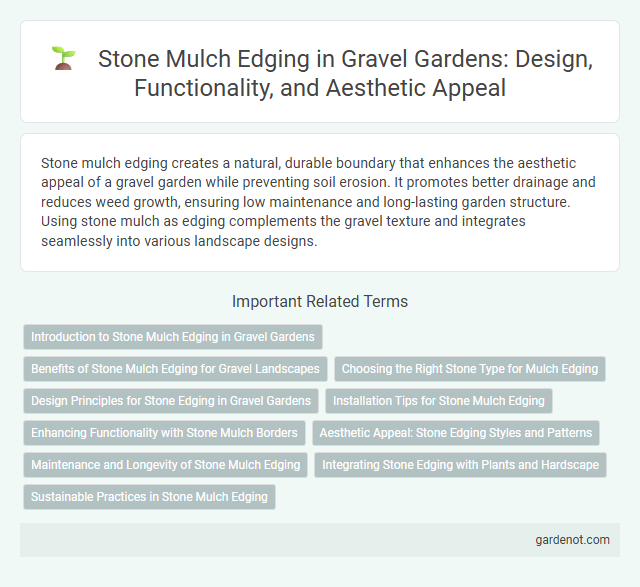Stone mulch edging creates a natural, durable boundary that enhances the aesthetic appeal of a gravel garden while preventing soil erosion. It promotes better drainage and reduces weed growth, ensuring low maintenance and long-lasting garden structure. Using stone mulch as edging complements the gravel texture and integrates seamlessly into various landscape designs.
Introduction to Stone Mulch Edging in Gravel Gardens
Stone mulch edging in gravel gardens provides a durable, low-maintenance boundary that enhances landscape definition and prevents gravel displacement. Composed of natural stones such as river rock, slate, or flagstone, this edging blends seamlessly with gravel for an organic aesthetic. Proper installation ensures effective weed control and improved drainage while maintaining the garden's visual appeal.
Benefits of Stone Mulch Edging for Gravel Landscapes
Stone mulch edging enhances gravel landscapes by providing superior erosion control and maintaining defined garden boundaries. Its porous nature improves drainage while minimizing weed growth, reducing maintenance efforts. Durable and visually appealing, stone mulch edging complements various garden styles, increasing landscape longevity and aesthetic value.
Choosing the Right Stone Type for Mulch Edging
Selecting the right stone type for mulch edging in a gravel garden involves considering factors such as durability, size, and color to complement the landscape design. Materials like granite, slate, and limestone offer long-lasting performance and aesthetic appeal, while smaller stones provide better coverage and weed suppression. Properly chosen stone mulch edging enhances soil moisture retention and defines garden borders with a natural, polished look.
Design Principles for Stone Edging in Gravel Gardens
Stone mulch edging in gravel gardens enhances both functionality and aesthetics by creating clear boundaries that prevent gravel migration and define planting areas. Effective design principles emphasize using natural stone sizes and colors that complement the gravel, ensuring a cohesive visual flow. Precise placement and consistent spacing maintain structural integrity while allowing for adequate drainage, promoting a sustainable and low-maintenance garden environment.
Installation Tips for Stone Mulch Edging
For effective stone mulch edging installation, start by defining the garden bed boundary with a garden hose or string to ensure a precise layout. Excavate a shallow trench about 2-3 inches deep, then place landscape fabric to prevent weed growth beneath the mulch. Finally, evenly spread 2-4 inches of stone mulch, compacting lightly to secure the stones and maintain a clean, durable edge that promotes soil moisture retention and bed definition.
Enhancing Functionality with Stone Mulch Borders
Stone mulch edging enhances gravel garden functionality by providing a durable and low-maintenance border that prevents gravel from spilling into unintended areas. It improves soil moisture retention and reduces weed growth along garden beds, contributing to healthier plant growth and a tidier landscape. The natural texture and color variations of stone mulch also add visual interest while seamlessly blending with various garden styles.
Aesthetic Appeal: Stone Edging Styles and Patterns
Stone mulch edging enhances gravel gardens with diverse styles such as cobblestone, flagstone, and river rock, creating visually striking borders. Patterns like herringbone, stacked, or irregular arrangements add texture and depth, elevating the garden's overall aesthetic appeal. This strategic use of stone edging not only defines garden spaces but also complements the natural tones and textures of gravel mulch.
Maintenance and Longevity of Stone Mulch Edging
Stone mulch edging offers low maintenance due to its durability and resistance to weathering, effectively preventing soil erosion and weed growth. Regular inspection and occasional replenishing of stones ensure the edging remains intact and functional over time. Its longevity is enhanced by proper installation, including a sturdy base and adequate drainage to avoid displacement and settling.
Integrating Stone Edging with Plants and Hardscape
Stone mulch edging enhances gravel gardens by seamlessly blending natural textures with surrounding plants and hardscape features. Selecting stones that complement plant colors and garden materials creates a cohesive visual flow while providing effective weed control and soil moisture retention. Incorporating curved or irregular stone patterns further softens hardscape lines, promoting harmony between organic and structural garden elements.
Sustainable Practices in Stone Mulch Edging
Stone mulch edging enhances gravel garden sustainability by reducing soil erosion and conserving moisture, promoting healthier plant growth. Utilizing locally sourced stone minimizes carbon footprint and supports eco-friendly landscaping practices. Proper installation ensures long-term durability, reducing the need for frequent replacements and waste.
Stone mulch edging Infographic

 gardenot.com
gardenot.com